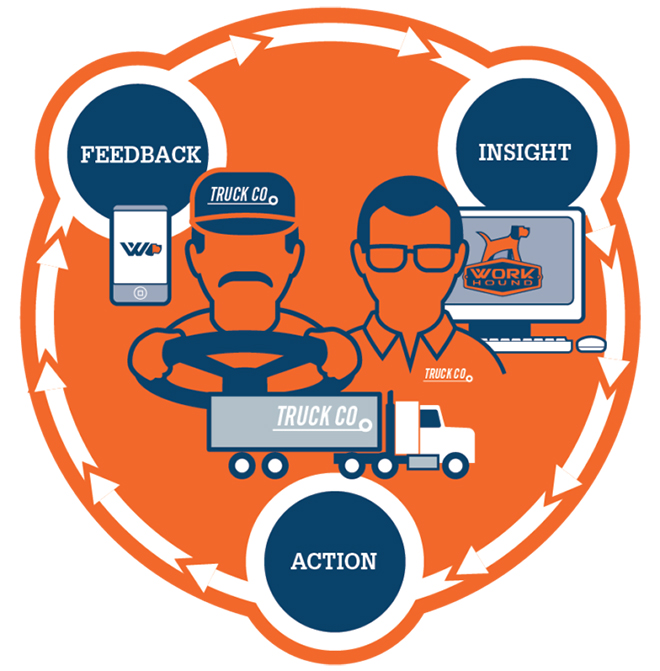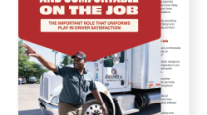Top Driver Complaints: Rude Staff, Pay, Intrusive In-Cab Technology, Analysts Say

Fleet drivers have issues with their carrier’s staff, the company’s approach to equipment and maintenance, technology in their cabs and feel that they have little control over their work, according to WorkHound, the Chattanooga, Tenn.-based provider of a smartphone-based system that allows truck drivers to anonymously discuss concerns they have with their employers.
WorkHound from January through November conducted an analysis of communications from more than 8,500 drivers at its client firms, which include medium-size to large carriers providing tanker, dry van, flatbed and expedited and services. In general, its clients have more than 100 drivers, with 89% being company drivers and the rest owner-operators.
WorkHound categorized the top four topics drivers have been discussing this year under people, equipment, logistics and pay.

This graphic shows the continuous communication that WorkHound fosters between drivers (via their smartphones) to WorkHound for analysis and on to the carrier. (WorkHound)
The people category covered driver attitudes on their treatment by the staff at their carrier and did not get into individuals. On the positive side drivers appreciated the family atmosphere, professionalism, and problem solving skills shown by staff, according to WorkHound.
On the negative side drivers didn’t appreciate staff rudeness, lack of empathy and suggestions on actions they should take that make them feel unsafe.
Issues with pay often come down to communication problems. Drivers feel they have to fight to be paid for all their miles driven or a reimbursement and that office staff don’t understand their frustration. Drivers get aggravated because they see this is an issue that continues every week.

Kirpalani (left) and Farrell. (WorkHound)
WorkHound co-founders Max Farrell and Andrew Kirpalani discussed the analysis during a conference call held by Stifel, Nicolaus & Co. and led by that firm’s managing director, John Larkin.
In addition to the analysis, the executives offered ideas on improving staff/driver interaction, noting that office life and road life are very different and that carriers might coach both drivers and office staff on each sides’ perspective on their jobs.
WorkHound is described as a continuous driver feedback software platform focused on driver turnover. In practice the idea is for carriers to offer the system so drivers have a “quick, simple in-and-out 90 seconds” to leave a message on any aspect of their jobs, Farrell said.
He said communication through a third-party firm like WorkHound encourages open-ended feedback from drivers, a group much in demand as the industry faces a turnover rate around 95% and a shortage of 50,000 drivers as estimated by American Trucking Associations.
You can't let #trucking driver feedback sit. You must act upon it immediately. Here's why: https://t.co/N5UU2cY23j #employeeengagement pic.twitter.com/dQIsEwA1R2 — WorkHound (@WorkHoundapp) June 2, 2017
Another major driver discussion was on equipment. Many drivers believe they are limited by industry and equipment challenges but that their carrier doesn’t consult with them on these issues. Further, there is a lack of transparency on truck maintenance.
Drivers are annoyed by in-cab devices and frustrated at system updates, believing that their GPS devices are outdated, and are especially infuriated at cameras that are pointed at them as they work.
The cameras make them feel as if their boss is watching them at work all day, then coming to their home and watching them there, too, the executives said.
Logistics concerns revolved around drivers believing they had little control over their day-to-day work while still appreciating that some carriers worked to accommodate their schedules and desire for certain routes.
In the WorkHound system a driver uses his smartphone to briefly post a note about an issue. The carrier then responds as it sees fit. It could go through WorkHound to find if the anonymous caller is willing to share his name and address the problem one-on-one. For topics with a broader impact the carrier could respond with a weekly fleetwide broadcast to drivers, Kirpalani said.
This feedback system works best when carriers make a senior executive the lead advocate on driver communications, then have one or more ‘quarterbacks’ interact with drivers, WorkHound said.




